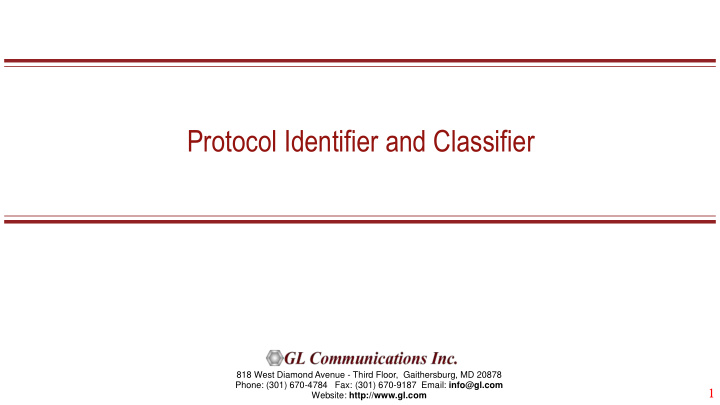



Protocol Identifier and Classifier 818 West Diamond Avenue - Third Floor, Gaithersburg, MD 20878 Phone: (301) 670-4784 Fax: (301) 670-9187 Email: info@gl.com 1 1 Website: http://www.gl.com
Protocol Identifier • Capable of detecting and classifying various protocols over T1/E1 lines. 2
Main Features • HDLC based, ATM, and TRAU protocol classification supported. • Classification of HDLC based protocols such as ISDN, SS7, PPP, Frame Relay, and GSM. • Graphical view displays the timeslots and subchannels of the identified protocols. • Statistical view displays the different protocols with the details of port, timeslots and subchannels. • Stream Statistics view shows the count of total number of timeslots, sub-channels, and hyper-channels used by each protocol. • Provides an option to log the protocol detected with device and channel information into a text file. • Ability to Save configurations from HDLC, ATM, and TRAU protocols in Protocol Identifier. • Detects protocols based on pre-defined configurations files for hyper-channels, sub-channels, and data rates. • Supports filtering to display the unique selected protocol. • Supports custom configuration of the colors to easily distinguish protocols. 3
Applications • Snapshot: Obtain a real-time snapshot of protocol traffic on T1E1 lines. • Surveillance: Identify protocol traffic on all the timeslots/sub channels simultaneously on multiple T1E1 lines. • Maintenance: Helps technicians to quickly identify the content of any T1 or E1. • Troubleshooting: Signaling (SS7, ISDN can be detected on any T1/E1 timeslots; this helps technicians to quickly identify the timeslot of signaling links for further protocol analysis. 4
Working Principle • Provides ready configurations for selecting various combination of channels, such as single timeslots, full rate hyper channels, multiple hyper-channels of different data rate – 64 kbbs, 56 kbps (bits 2-8), 56 kbps(bits 1-7), or sub-channels of 8k to 56k combinations. 5
Graphical View • Graphical View identifies the protocols on each timeslot and sub channel of T1/E1 ports being monitored, and indicates using different colors. • The colors can be customized for different protocols as per user requirement. 6
Statistical View • This reports the protocols identified on each timeslot and sub channels row-wise. • For example, the screen shows that the TRAU frames are identified on Port 1, timeslots 3 – sub channel 1 – 2 , timeslot 3 – sub channels 3 – 4, timeslot 4 – sub channel 1 – 2, and timeslot 4 – sub channel 3 – 4. 7
Traffic Flow View (Stream Stats View) • This displays the stream statistics such as the total count of hyper channels, timeslots, and sub channels used by individual protocols in a tabular format. • It is an indication of the overall bandwidth consumption by the monitored traffic. 8
Stream Scan View • This displays the scanning of the selected configurations for every 5sec, 10sec, 20sec, or more as specified in the Scan Time . 9
Multiple Ports and Timeslots • Protocols Identifier is capable of identifying protocols on multiple ports and timeslots, which requires respective GL's protocol analyzers configuration file. 10
Log Statistics • The details of the protocols identified, time, timeslots, subchannels, hyper- channels, and device name can be logged into a text file in the desired location for further analysis. 11
Thank you! For more details refer to https://www.gl.com/protocol-identifier.html 12
Recommend
More recommend